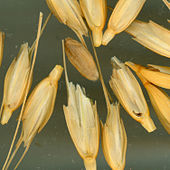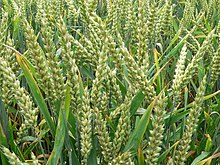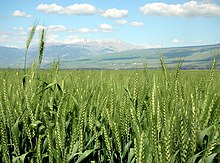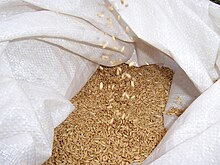Wheat (Triticum spp.)[1] is a grass, originally from the Fertile Crescent region of the Near East, but now cultivated worldwide. In 2007 world production of wheat was 607 million tons, making it the third most-produced cereal after maize (784 million tons) and rice (651 million tons).[2] Globally, wheat is the leading source of vegetable protein in human food, having a higher protein content than either maize (corn) or rice, the other major cereals. In terms of total production tonnages used for food, it is currently second to rice as the main human food crop, and ahead of maize, after allowing for maize's more extensive use in animal feeds.
 Wheat was a key factor enabling the emergence of city-based societies at the start of civilization because it was one of the first crops that could be easily cultivated on a large scale, and had the additional advantage of yielding a harvest that provides long-term storage of food. Wheat grain is a staple food used to make flour for leavened, flat and steamed breads, biscuits, cookies, cakes, breakfast cereal, pasta, noodles, couscous[3] and for fermentation to make beer,[4] other alcoholic beverages,[5] or biofuel.[6]
Wheat was a key factor enabling the emergence of city-based societies at the start of civilization because it was one of the first crops that could be easily cultivated on a large scale, and had the additional advantage of yielding a harvest that provides long-term storage of food. Wheat grain is a staple food used to make flour for leavened, flat and steamed breads, biscuits, cookies, cakes, breakfast cereal, pasta, noodles, couscous[3] and for fermentation to make beer,[4] other alcoholic beverages,[5] or biofuel.[6]Wheat is planted to a limited extent as a forage crop for livestock, and its straw can be used as a construction material for roofing thatch.[7][8] The husk of the grain, separated when milling white flour, is bran. Wheat germ is the embryo portion of the wheat kernel. It is a concentrated source of vitamins, minerals, and protein, and is sustained by the larger, starchstorage region of the kernel—the endosperm.
History
Wheat is one of the first cereals known to have been domesticated and wheat's ability to self-pollinate greatly facilitated the selection of many distinct domesticated varieties. The archaeological record suggests that this first occurred in the regions known as the Fertile Crescent, and the Nile Delta. These include southeastern parts of Turkey, Syria, the Levant, Israel, and Egypt. Recent findings narrow the first domestication of wheat down to a small region of southeastern Turkey,[9] and domesticated Einkorn wheat at Nevalı Çori—40 miles (64 km) northwest of Gobekli Tepe in Turkey—has been dated to 9,000 B.C.[10] However evidence for the exploitation of wild barley has been dated to 23,000 B.C. and some say this is also true of pre-domesticated wheat.[11]
Wheat origins near Turkey's Karacadag Mountains
Genetic analysis of wild einkorn wheat suggests that it was first grown in the Karacadag Mountains in southeastern Turkey. Dated archeological remains of einkorn wheat in settlement sites near this region, including those at Abu Hureyra, confirms the domestication of einkorn near the Karacadag Mountain Range. The earliest carbon-14 date for the einkorn wheat remains at Abu Hureyra is 7800 to 7500 years BCE.[12] Recent genetic and archeological discoveries indicate that both emmer wheat and durum (hard pasta wheat) also originated from this same Karacadag region of southeastern Turkey. Remains of harvested emmer from several sites near the Karacadag Range have been dated to between 8,800 BCE and 8,400 BCE, that is, in the Neolithic period.[13]
Cultivation and repeated harvesting and sowing of the grains of wild grasses led to the creation of domestic strains, as mutant forms ('sports') of wheat were preferentially chosen by farmers. In domesticated wheat, grains are larger, and the seeds (spikelets) remain attached to the ear by a toughened rachis during harvesting. In wild strains, a more fragile rachis allows the ear to easily shatter and disperse the spikelets.[14] Selection for these traits by farmers might not have been deliberately intended, but simply have occurred because these traits made gathering the seeds easier; nevertheless such 'incidental' selection was an important part of crop domestication. As the traits that improve wheat as a food source also involve the loss of the plant's natural seed dispersal mechanisms, highly domesticated strains of wheat cannot survive in the wild.
Cultivation of wheat began to spread beyond the Fertile Crescent after about 8,000 BCE. Jared Diamond traces the spread of cultivated emmer wheat starting in the Fertile Crescent about 8500 BCE, reaching Greece, Cyprus and India by 6500 BCE, Egypt shortly after 6000 BCE, and Germany and Spain by 5000 BCE [15]. "The early Egyptians were developers of bread and the use of the oven and developed baking into one of the first large-scale food production industries." [16] By 3,000 BCE, wheat had reached England, and Scandinavia. A millennium later it reached China.
Wheat spread through out Europe and in England, thatch was used for roofing in the bronze age, and was in common use until the late 19th century.[17]
Farming techniques
Technological advances in soil preparation and seed placement at planting time, use of crop rotation and fertilizers to improve plant growth, and advances in harvesting methods have all combined to promote wheat as a viable crop. Agricultural cultivation using horse collar leveraged plows (at about 3000 BCE) was one of the first innovations that increased productivity. Much later, when the use of seed drills replaced broadcasting sowing of seed in the 18th century, another great increase in productivity occurred. Yields of wheat per unit area increased as methods of crop rotation were applied to long cultivated land, and the use of fertilizers became widespread. Improved agricultural husbandry has more recently included threshing machines and reaping machines (the 'combine harvester'), tractor-drawn cultivators and planters, and better varieties (see green revolution and Norin 10 wheat). Great expansions of wheat production occurred as new arable land was farmed in the Americas and Australia in the 19th and 20th centuries.
Genetics
 |
| Spikelets of a hulled wheat, einkorn |
- Einkorn wheat (T. monococcum) is diploid (AA, two complements of seven chromosomes, 2n=14).[1]
- Most tetraploid wheats (e.g. emmer and durum wheat) are derived from wild emmer, T. dicoccoides. Wild emmer is itself the result of a hybridization between two diploid wild grasses, T. urartu and a wild goatgrass such as Aegilops searsii or Ae. speltoides. The unknown grass has never been identified among now surviving wild grasses, but the closest living relative is Aegilops speltoides. The hybridization that formed wild emmer (AABB) occurred in the wild, long before domestication,[18]and was driven by natural selection.
- Hexaploid wheats evolved in farmers' fields. Either domesticated emmer or durum wheat hybridized with yet another wild diploid grass (Aegilops cylindrica) to make the hexaploid wheats, spelt wheat and bread wheat.[18] These have three sets of paired chromosomes, three times as many as in diploid wheat.
The presence of certain versions of wheat genes has been important for crop yields. Apart from mutant versions of genes selected in antiquity during domestication, there has been more recent deliberate selection of alleles that affect growth characteristics. Genes for the 'dwarfing' trait, first used by Japanese wheat breeders to produce short-stalked wheat, have had a huge effect on wheat yields world-wide, and were major factors in the success of the Green revolution in Mexico and Asia. Dwarfing genes enable the carbon that is fixed in the plant during photosynthesis to be diverted towards seed production, and they also help prevent the problem of lodging. 'Lodging' occurs when a ear stalk falls over in the wind and rots on the ground, and heavy nitrogenous fertilization of wheat makes the grass grow taller and become more susceptible to this problem. By 1997, 81% of the developing world's wheat acreage was planted to semi-dwarf wheats, giving both increased yields and better response to nitrogenous fertilizer.
Wild grasses in the genus Triticum and related genera, and grasses such as rye have been a source of many disease-resistance traits for cultivated wheat breeding since the 1930s.[19]
Heterosis, or hybrid vigor (as in the familiar F1 hybrids of maize), occurs in common (hexaploid) wheat, but it is difficult to produce seed of hybrid cultivars on a commercial scale (as is done with maize) because wheat flowers are complete and normally self-pollinate. Commercial hybrid wheat seed has been produced using chemical hybridizing agents; these chemicals selectively interfere with pollen development, or naturally occurring cytoplasmic male sterility systems. Hybrid wheat has been a limited commercial success in Europe (particularly France), the USA and South Africa.[20] F1 hybrid wheat cultivars should not be confused with the standard method of breeding inbred wheat cultivars by crossing two lines using hand emasculation, then selfing or inbreeding the progeny many (ten or more) generations before release selections are identified to be released as a variety or cultivar.
Synthetic hexaploids made by crossing the wild goatgrass wheat ancestor Aegilops tauschii and various durum wheats are now being deployed, and these increase the genetic diversity of cultivated wheats.
Stomata (or leaf pores) are involved in both uptake of carbon dioxide gas from the atmosphere and water vapor losses from the leaf due to water transpiration. Basic physiological investigation of these gas exchange processes has yielded valuable carbon isotope based methods that are used for breeding wheat varieties with improved water-use efficiency. These varieties can improve crop productivity in rain-fed dry-land wheat farms.[21]
In 2010, a team of scientists announced they had decoded the wheat genome for the first time (95% of the genome of a variety of wheat known as Chinese Spring line 42).[22] This announcement was widely misreported as representing a finished genome sequence. In fact, sequence data was produced which allows the identification of wheat genes, but the data was not assembled to represent the map of the genome. Information on current wheat genome sequencing activities can be found at http://www.wheatgenome.info/
Plant Breeding
 |
| Wheat |
 |
| Baled and stacked wheat |
 |
| Wheat |
Hulled vs Free-Treshing Wheat
The four wild species of wheat, along with the domesticated varieties einkorn,[25] emmer[26] andspelt,[27] have hulls. This more primitive morphology (in evolutionary terms) consists of toughened glumes that tightly enclose the grains, and (in domesticated wheats) a semi-brittle rachis that breaks easily on threshing. The result is that when threshed, the wheat ear breaks up into spikelets. To obtain the grain, further processing, such as milling or pounding, is needed to remove the hulls or husks. In contrast, in free-threshing (or naked) forms such as durum wheat and common wheat, the glumes are fragile and the rachis tough. On threshing, the chaff breaks up, releasing the grains. Hulled wheats are often stored as spikelets because the toughened glumes give good protection against pests of stored grain.[25]
Naming
There are many botanical classification systems used for wheat species, discussed in a separate article on Wheat taxonomy. The name of a wheat species from one information source may not be the name of a wheat species in another.
 |
| A mature wheat field in Israel |
- growing season, such as winter wheat vs. spring wheat,[8] by gluten content, such as hard wheat (high protein content) vs. soft wheat (high starch content), or by grain color (red, white or amber).
- Protein content. Bread wheat protein content ranges from 10% in some soft wheats with high starch contents, to 15% in hard wheats.
- The quality of the wheat protein gluten. This protein can determine the suitability of a wheat to a particular dish. A strong and elastic gluten present in bread wheats enables dough to trap carbon dioxide during leavening, but elastic gluten interferes with the rolling of pasta into thin sheets. The gluten protein in durum wheats used for pasta is strong but not elastic.
- Grain color (red, white or amber). Many wheat varieties are reddish-brown due to phenolic compounds present in the bran layer which are transformed to pigments by browning enzymes. White wheats have a lower content of phenolics and browning enzymes, and are generally less astringent in taste than red wheats. The yellowish color of durum wheat and semolina flour made from it is due to a carotenoidpigment called lutein, which can be oxidized to a colorless form by enzymes present in the grain.
Major Cultivated Species of wheat
 |
| Sack of whea |
Durum (T. durum) – The only tetraploid form of wheat widely used today, and the second most widely cultivated wheat.
Einkorn (T. monococcum) – A diploid species with wild and cultivated variants. Domesticated at the same time as emmer wheat, but never reached the same importance.
Emmer (T. dicoccum) – A tetraploid species, cultivated in ancient times but no longer in widespread use.
Spelt (T. spelta) – Another hexaploid species cultivated in limited quantities.
Classes used in the United States are
Classes used in the United States are
- Durum – Very hard, translucent, light-colored grain used to make semolina flour for pasta.
- Hard Red Spring – Hard, brownish, high-protein wheat used for bread and hard baked goods. Bread Flour and high-gluten flours are commonly made from hard red spring wheat. It is primarily traded at the Minneapolis Grain Exchange.
- Hard Red Winter – Hard, brownish, mellow high-protein wheat used for bread, hard baked goods and as an adjunct in other flours to increase protein in pastry flour for pie crusts. Some brands of unbleached all-purpose flours are commonly made from hard red winter wheat alone. It is primarily traded by the Kansas City Board of Trade. One variety is known as "turkey red wheat", and was brought to Kansas by Mennonite immigrants from Russia.[28]
- Soft Red Winter – Soft, low-protein wheat used for cakes, pie crusts, biscuits, and muffins. Cake flour, pastry flour, and some self-rising flours with baking powder and salt added, for example, are made from soft red winter wheat. It is primarily traded by the Chicago Board of Trade.
- Hard White – Hard, light-colored, opaque, chalky, medium-protein wheat planted in dry, temperate areas. Used for bread and brewing.
- Soft White – Soft, light-colored, very low protein wheat grown in temperate moist areas. Used for pie crusts and pastry. Pastry flour, for example, is sometimes made from soft white winter wheat.
- Red wheats may need bleaching; therefore, white wheats usually command higher prices than red wheats on the commodities market.
As a Food
 |
| Cracked wheat. |
Nutrition
 100 grams of hard red winter wheat contain about 12.6 grams of protein, 1.5 grams of total fat, 71 grams of carbohydrate (by difference), 12.2 grams of dietary fiber, and 3.2 mg of iron (17% of the daily requirement); the same weight of hard red spring wheat contains about 15.4 grams of protein, 1.9 grams of total fat, 68 grams of carbohydrate (by difference), 12.2 grams of dietary fiber, and 3.6 mg of iron (20% of the daily requirement).[29]
100 grams of hard red winter wheat contain about 12.6 grams of protein, 1.5 grams of total fat, 71 grams of carbohydrate (by difference), 12.2 grams of dietary fiber, and 3.2 mg of iron (17% of the daily requirement); the same weight of hard red spring wheat contains about 15.4 grams of protein, 1.9 grams of total fat, 68 grams of carbohydrate (by difference), 12.2 grams of dietary fiber, and 3.6 mg of iron (20% of the daily requirement).[29]Much of the carbohydrate fraction of wheat is starch. Wheat starch is an important commercial product of wheat, but second in economic value to wheat gluten.[30] The principal parts of wheat flour are gluten and starch. These can be separated in a kind of home experiment, by mixing flour and water to form a small ball of dough, and kneading it gently while rinsing it in a bowl of water. The starch falls out of the dough and sinks to the bottom of the bowl, leaving behind a ball of gluten.
Health Concern
Roughly 1% of Indian populations[31][32] has coeliac (also written as celiac) disease—a condition that is caused by an adverse immune system reaction to gliadin, a gluten protein found in wheat (and similar proteins of the tribe Triticeae which includes other species such asbarley and rye). Upon exposure to gliadin, the enzyme tissue transglutaminase modifies the protein, and the immune system cross-reacts with the bowel tissue, causing an inflammatory reaction. That leads to flattening of the lining of the small intestine, which interferes with the absorption of nutrients. The only effective treatment is a lifelong gluten-free diet.
The estimate for people in the United States is between 0.5 and 1.0 percent of the population.[33][34][35] While the disease is caused by a reaction to wheat proteins, it is not the same as wheat allergy.
Retrieved From : Wikipedia
PAGE 1 OF 2 : NEXT PAGE
Retrieved From : Wikipedia
PAGE 1 OF 2 : NEXT PAGE


No comments:
Post a Comment